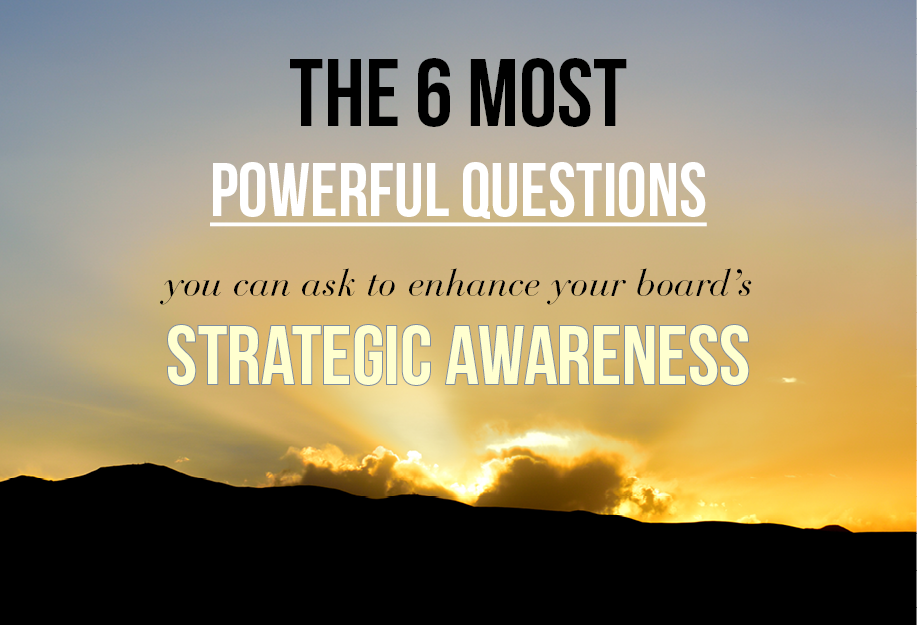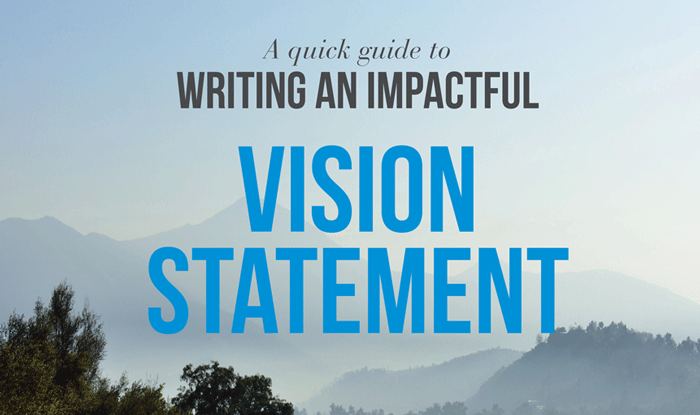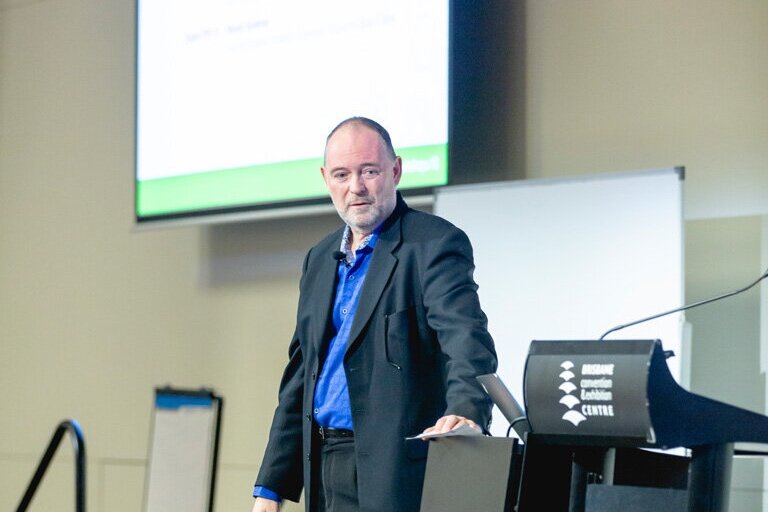
A Few Good Ideas To Read & Share
Subscribe to the blog digest below
You may re-use any of these blog articles for your own publication provided you reference it with a working URL.
Most Popular
“In camera” is a Latin term which can be understood to mean an "in private" session in this context. It involves a confidential meeting, or a portion of a meeting, taking place with only Board members present.
Strategic awareness rarely features in modern textbooks on management, yet is something that can fundamentally change conversations and decision-making at the Board level.
In essence, strategic awareness is the...
Removing a Director should occur either by performance management (e.g. Board evaluation results), structural management (e.g. term limits or constitutional and/or legal requirements invoked), or by perception management (e.g. offering a position on an advisory committee)
Many CEOs we have worked with can recount a situation where they have been involved in an AGM (not necessarily their own) that have dissolved into farce and acrimony, leaving the organization in confusion and Board and staff unsure what to do next.
Have you ever had (or heard of) the situation where one or more Board members were either consistently late, or were not turning up on a regular basis (with or without pre-warning)?
The strategic planning process is often too operational, inefficient and not nearly strategic enough. Employ these seven tips to give your planning team the best running start for your next strategic plan.
Strategic Planning
The role of an advisory board is to ask questions that would not normally be considered or asked by a business, and open up the conversation so that a company can be more strategic. Yet advisory boards are a much under-utilised resource that are often not well understood.
Strategic planning sessions can be conducted remotely, without the need for people to meet in person. This article outlines the four key components of any strategic plan and the process for the most effective strategic plan facilitation sessions.
Action planning should be viewed as the architecture of your strategic goal setting. Without a realistic set of incremental steps, overarching strategies are not likely to form in the way you would like (if at all).
The role of scenario planning is crucial for any business – it opens a constructive space with which to index all the environmental risks which could disrupt your organization, and discuss how your resources could be allocated to minimize their impact should they play out.
Have you ever had (or heard of) the situation where one or more Board members were either consistently late, or were not turning up on a regular basis (with or without pre-warning)?
The strategic planning process is often too operational, inefficient and not nearly strategic enough. Employ these seven tips to give your planning team the best running start for your next strategic plan.
Your organization's strategic plan sets the trajectory for its future. It is very important to make the most of this process and that starts with choosing the strategic planning team.
The strategic value of asking the right questions, especially during board meetings, is rarely tapped into. Start use the six most powerful questions below and watch the effectiveness of your board skyrocket.
One of the most powerful tools for creating strategic awareness in your nonprofit organization is your Vision statement.
Governance & Board Dynamics
In this AICD article written by Jessica Mudditt, governance experts including Steven Bowman FAICD explain why board portals play a pivotal role in streamlining governance processes and communicating more effectively and efficiently with directors.
Before you say yes to your first not-for-profit board, find out what you need to know, the questions you should ask and what can happen if governance goes wrong. Article featuring Steven Bowman and written by Domini Stuart, Journalist, AICD.
In his AICD article, Steven Bowman FAICD discusses the transformative role of board portals in modern governance and how these tools not only streamline compliance through features like secure document sharing and AI-driven insights, but also enhance strategic decision-making by integrating compliance with broader organizational goals.
The role of an advisory board is to ask questions that would not normally be considered or asked by a business, and open up the conversation so that a company can be more strategic. Yet advisory boards are a much under-utilised resource that are often not well understood.
There are unique aspects of governing social enterprises, which blend for-profit business models with social missions. Whilst the fundamental governance requirements for social enterprises align with those of traditional organizations, there are distinct considerations due to their dual objectives.
Privatising public sector assets is an issue that polarises public sentiment. Which is one of the reasons why directors of public sector businesses must pay such close attention to their fiduciary duties.
Many boards focus excessively on operational details, which can detract from high-level strategic discussions. Prioritizing key strategic issues by placing them at the forefront of meetings ensures directors address them when energy and focus are optimal.
Key Performance Indicators and performance management frameworks tailored specifically for CEOs are of critical importance. Establishing a robust governance framework can significantly impact an organization's trajectory.
Without a solid foundation in compliance, even the best-laid plans can quickly unravel. Compliance isn’t just about ticking boxes or avoiding penalties—it's about ensuring that your organisation operates with integrity and is positioned for sustainable success.
A well-organised board agenda is more than just a checklist for directors. It’s a critical tool that shapes the discussions and decisions made in every meeting, driving the future of the organisation.
One of the core responsibilities of board directors is to ensure that the organisation's governance structures are robust, relevant, and legally compliant. Yet, the importance of regularly reviewing constitutions is often overlooked until something goes wrong.
Bowman’s main message was that each item for a board agenda would be linked to one of the fund’s strategic goals. He urged chairs to rigorously enforce this, partly as a means of preventing “personal gripes that go on for ages” from individual directors. Such a policy would also mean that agendas should not have an item labelled as “any other business”.
Your Vision statement is more than a catch phrase: it's a call to arms and one of the most powerful innovation tools available. But you need to know how to use it. The real question is: How well do we map our existing business, services and programs against the key elements of our Vision statement, and how well do we “walk the talk”?
Have you ever been trapped in a Board meeting that has totally lost its focus? Do you dread Board or staff meetings that achieve little or nothing? Sometimes, without even knowing it, any Director can waste the time of the Board by leaning into operations rather than strategic governance. So how do you handle the toxic trap of micromanagement?
With current increased uncertainty and complexity, it may be tempting to put off the board meetings for your board or committee because you can’t meet face-to-face. But do you really need to cancel or simply pivot?
Given the pace of change and complexity in today’s business environment, Advisory Boards are often underutilized resources for strategic, high-value information and guidance.
For many corporate and nonprofit organisations alike, the need to evaluate the Board of directors, the strengths, weaknesses and skills gap at any given time, is critical to managing its effectiveness. Leverage these strategies and put your crosshairs on the areas that need the most improvement.
How you view the role of the Board can have a big impact on its effectiveness. Does your Board meet to tick the boxes on compliance? Or is it about choices and creation? This free white paper, Choices, Future, Communities, is a wake-up call to anyone who thinks they are too small to make a difference.
Despite the challenges of regulatory uncertainty and economic pressure, a space to begin proactive discussions around mergers, acquisitions and other forms of sustainable growth has been created for organisations which are willing and prepared.
How prepared an organization is to detect, respond and recover from a cyber attack will determine its resilience following the inevitable data or security breach it will suffer some day. Are you preapred for the inevitable?
Reasonable people can disagree on important issues. But what do you do if you firmly believe the consensus decision is wrong and that the Board is veering toward a decision that could be extremely damaging?
In a recent study, less than half the nonprofit CEOs surveyed said they did not have an adequate succession planning process in place. If building a board leadership pipeline is among the most important areas for board improvement, why does it routinely fail to take priority?
Use the following as a sample of Director standards with which to inform and assess each Director on the Board as well as incoming candidates or volunteers.
If decision making around the Board room is likely to recede into the weeds its productivity and effectiveness is greatly diluted. The Board induction program is the first and greatest opportunity to set personal expectations from the beginning of a Director’s tenure.
“In camera” is a Latin term which can be understood to mean an "in private" session in this context. It involves a confidential meeting, or a portion of a meeting, taking place with only Board members present.
Strategic awareness rarely features in modern textbooks on management, yet is something that can fundamentally change conversations and decision-making at the Board level.
In essence, strategic awareness is the...
The primary reason driving most mergers is to gain some type of advantage or to stave off some sort of disaster. The only way organizations can decide if a merger makes sense is to evaluate whether it significantly advances their vision and strategic objectives. Since these strategies are, presumably, designed to increase the ability of the organization to deliver against its vision, their accomplishment should, by definition, increase profitability.
Many nonprofit organizations elect or appoint an individual to the position of Treasurer and that person is deemed responsible for the financial management of the organization.
One of the key assets of any nonprofit organization is its CEO (or MD, EO, GM, Coordinator or any other title that represents the chief staff leader). A primary reason many great CEOs choose to leave their organization is due to poor handling of their performance management by the Board, or sometimes not at all.
The relationship between the nonprofit Board Chair and the CEO is arguably the most important relationship in the organization.
Leadership
Key Performance Indicators and performance management frameworks tailored specifically for CEOs are of critical importance. Establishing a robust governance framework can significantly impact an organization's trajectory.
One of the core responsibilities of board directors is to ensure that the organisation's governance structures are robust, relevant, and legally compliant. Yet, the importance of regularly reviewing constitutions is often overlooked until something goes wrong.
A common theme for many Boards is not knowing how to deal with conversations that go off the rails. Here are some key strategies, including how to use your Vision Statement, to help bring Board interactions and conversations back on track.
One of the key elements of a high performing Board, is the presence of a mandatory mentoring system for new Board members. If this is something you believe your new Board members would welcome, then here are some guidelines we have found useful when designing mentoring programs for new Board members.
The day a person joins the leadership team on a board of directors is the day they become liable for the decisions of the board. Preparing new board members for this responsibility is the function of a well-designed board induction program.
Have you ever dreamed of having a waiting list of high performing Directors who know about your organization, who know what it means to be strategic, and who ask questions from Day 1 that open up insights and possibilities for everyone on your Board?
Reasonable people can disagree on important issues. But what do you do if you firmly believe the consensus decision is wrong and that the Board is veering toward a decision that could be extremely damaging?
What do you do when a new Director is not performing to the standard expected of them? Whether this Director was tapped on the shoulder or was the successful applicant, ongoing performance should be non-negotiable.
In a recent study, less than half the nonprofit CEOs surveyed said they did not have an adequate succession planning process in place. If building a board leadership pipeline is among the most important areas for board improvement, why does it routinely fail to take priority?
Cultivating what it means to be a conscious leader is not a deception, pretense or a performance. It is a deliberate choice about how you choose to live and about how you choose to be a leader at work and in your life.
Risk Management
Risk is an often misunderstood concept in governance, especially when it is contained at all costs and never explored for potential gian.
Risk and uncertainty are forces that are part of everyday life. How you respond to risk can be the difference between an enduring organization and an endangered one.
Culture
Research has found direct links between culture and performance of an organisation. In this video, Steve Simpson and Steven Bowman discuss UGR’s (Unwritten Ground Rules) that demonstrate how well an organisation’s vision and values are being lived in the workplace.
Why do some companies succeed in creating new markets while others fail?This question has driven the work of W. Chan Kim and Renée Mauborgne over the past ten years and led them to conceptualize a framework for business innovation and success: Blue Ocean Strategy.
Strategic awareness rarely features in modern textbooks on management, yet is something that can fundamentally change conversations and decision-making at the Board level.
In essence, strategic awareness is the...
Have you ever seen one of your close peers receive a promotion, or be appointed to a Board, only to then treat you and existing workplace friends in a different, negative way?
This commonly accepted business practice tends to compel people to believe that they need to cut costs to improve revenue and profit, making expenses the focus of the business strategy, not revenue generation. This often leads management to make decisions that actually harm the organization.
When it comes to financing a nonprofit, there are many uphill battles. The two greatest factors that either create or limit prosperity and abundance in a nonprofit organization are...
The following list is a compilation of tactics and behaviors which may seem unconventional, but form the foundations of a resilient business that can sustain conscious growth.
Have you ever had (or heard of) the situation where one or more Board members were either consistently late, or were not turning up on a regular basis (with or without pre-warning)?
For innovation to thrive in an organization, the CEO plus Board of Directors must actively promote the right culture.
The thinking habits of an organization's Board of directors plays an important role in shaping the culture of its workforce and the effectiveness of its strategies.
The strategic value of asking the right questions, especially during board meetings, is rarely tapped into. Start use the six most powerful questions below and watch the effectiveness of your board skyrocket.
One of the most powerful tools for creating strategic awareness in your nonprofit organization is your Vision statement.
The Conscious CEO Series
What are you really saying when you present your board report as a commentary on how 'busy' you have been? This common approach should be abandoned in favor of board reports that focus on your strategic plan.
Removing an underperforming Board member is an exercise that must be handled with care especially if the director in question still feels passionately about the organization, but are unsuitable for future tenure.
What's the best way to cultivate leadership qualities, regardless of your formal job title?
Risk is an often misunderstood concept in governance, especially when it is contained at all costs and never explored for potential gian.
The relationship between the nonprofit Board Chair and the CEO is arguably the most important relationship in the organization. What does it take to nurture the relationship, even bring it back from the brink?
Biased information sources make it difficult for the correct decision to be made, but often it's the behavior of those in leadership positions who can be at fault.
How can the typical Board evaluation be used to provide feedback to Board members and improve the overall work of the Board?

















































![[Watch] Creating the Culture the Board Requires](https://images.squarespace-cdn.com/content/v1/51b64d8ae4b0c042edeecd7e/1632784504737-TF7OC5NS90GWFS0LJ06X/campaign-creators-gMsnXqILjp4-unsplash.jpg)
















Use the following as a sample of Director standards with which to inform and assess each Director on the Board as well as incoming candidates or volunteers.